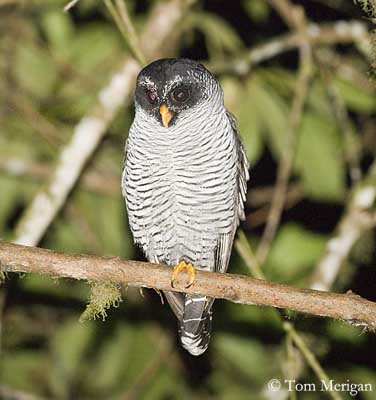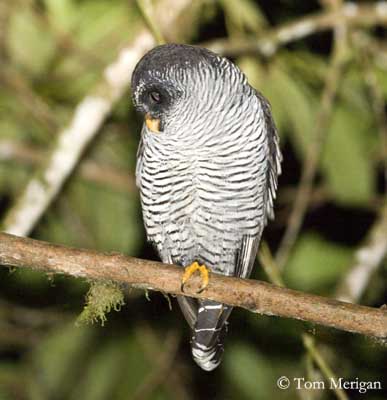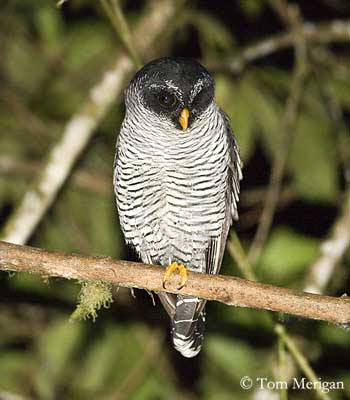
DIET:
The Black-and-white Owl feeds mainly on insects such as Coleopterans and Orthopterans, but also takes small rodents, bats in flight, small birds and amphibians. It usually hunts from a perch or on the wing.
PROTECTION / THREATS / STATUS:
The Black-and-white Owls are often seen in small populations. According to the range, they can be fairly common in Mexico, scarce in Honduras, Costa Rica and Panama, and very rare in Colombia and Venezuela.
This owl is threatened by deforestation and forest clearance, and the use of pesticides may also affect the species. However, the Black-and-white Owl is not threatened at this moment.
Fr: Chouette à lignes noires
All : Bindenhalskauz
Esp: Cárabo Blanquinegro
Ital: Civetta fasciata bianco e nera
Nd: Zwartwitte Bosuil
Photographer:
Tom Merigan
Tom Merigan’s Photo Galleries
Text by Nicole Bouglouan
Sources:
HANDBOOK OF THE BIRDS OF THE WORLD Vol 5 by Josep del Hoyo-Andrew Elliott-Jordi Sargatal - Lynx Edicions - ISBN: 8487334253
A GUIDE TO THE BIRDS OF MEXICO AND NORTHERN CENTRAL AMERICA by Steve N. G. Howell, Sophie Webb - Oxford University Press - ISBN: 0198540124
A GUIDE TO THE BIRDS OF COLOMBIA by Steven L. Hilty and William L. Brown - Princeton University Press – ISBN 069108372X
Animal Diversity Web (University of Michigan Museum of Zoology)
Owling.com – The largest US website totally dedicated to owls
SORA Searchable Ornithological Research Archive (Blair O. Wolf)
Black-and-white Owl
Strix nigrolineata
Strigiforme Order – Strigidae Family
BIOMETRICS:
Length: 33-45 cm
Weight: M: 435 g – F: 535 g
DESCRIPTION:
The Black-and-white Owl is active only at night.
Both sexes are similar, but female is larger than male and has longer wings.
Adult has sooty-brown to blackish upperparts. The tail shows four narrow white bars. The legs are feathered white with dark bars.
Underparts are white, all narrowly barred dark brown to blackish.
This black-and-white pattern extends to the neck sides, the nape and the upper back.
The head is rounded, with black facial disk. Eyebrows are speckled white. Crown is blackish.
Eyes are dark brown. Bill and feet are orange-yellow.
Juvenile has whitish face, white barred dark brown upperparts and buffy-white barred dark underparts.

VOICE: SOUNDS BY XENO-CANTO
The Black-and-white Owl utters deep, resonant hoots, usually three notes “huwhoOOo”, but also longer series “who-who-WHOH-who”, or “ha-ha-HAH-ha”.
We can also hear a high-pitched catlike scream “wheeahew” or “meeeowh”, rapid series of several notes “whuk-whuk-whuk…”, and a harder “rreah’k”.
During these vocal series, tone and volume are increasing, but the final note is usually lower.
HABITAT:
The Black-and-white Owl frequents humid forest, semi-deciduous and deciduous, forest borders, edges and clearing with trees, tall mangroves, and wooded areas near water. It may be found near villages.
This species can be seen from sea-level up to 1200 metres of elevation in Mexico, up to 2100 metres in Panama and up to 2400 metres in Colombia.
RANGE:
The Black-and-white Owl is resident in its range from C Mexico to NW Venezuela, W Colombia, W Ecuador and NW Peru.
BEHAVIOUR:
The Black-and-white Owl feed primarily on insects such as Coleopterans and Orthopterans. It also takes small vertebrates (rodents and bats) and probably birds.
This owl hunts from a perch, but flying insects and bats are caught in flight. It also hunts in artificial lights near villages.
This bird is strictly nocturnal. It rests during the day, perched in trees and motionless. It is usually solitary, but small flocks can be seen outside the breeding season.

The Black-and-white Owls are monogamous. At the beginning of the breeding season, when they are ready to mate, they give a hooting mating call, a series of “who”.
To attract a female, the male flaps its wings and move rapidly its body, and also performs aerial displays with acrobatic flights.
During the breeding season, the male is strongly territorial. It can attack all kinds of intruders including humans if they approach too close a nest.
It also uses the same displays such as flight and wing clapping to chase away the intruders.
FLIGHT:
The Black-and-white Owl performs acrobatic flight displays and can be very agile when hunting flying bats or insects.
Usually, owls are good fliers and have silent flight.
REPRODUCTION:
The Black-and-white Owl breeds during the dry season, between late March and late May.
The owls nest in holes in trees, or use abandoned nests of other species. This owl may also use old stick nests.
If the food resources are insufficient, the female may not breed or lay fewer eggs. But usually, she lays one or two eggs. Incubation lasts between 15 and 35 days. There is not more information about this species.
